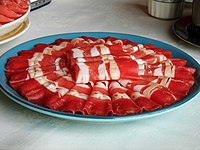
Photo from wikipedia
This study aimed to identify the best UV-C combined treatments for ensuring the safety and quality of fish and meat products. A total of 4592 articles were screened in the… Click to show full abstract
This study aimed to identify the best UV-C combined treatments for ensuring the safety and quality of fish and meat products. A total of 4592 articles were screened in the relevant databases, and 16 were eligible studies. For fish, the most effective treatments to reduce Gram-negative and Gram-positive bacteria were UV-C at 0.5 J/cm2 + non-thermal atmospheric plasma (NTAP) for 8 min (33.83%) and 1% Verdad N6 + 0.05 J/cm2 + vacuum packaging (25.81%), respectively. An oxygen absorber with 0.102 J/cm2 was the best combined treatment, reducing lipid oxidation (65.59%), protein oxidation (48.95), color (ΔE = 4.51), and hardness changes (18.61%), in addition to a shelf-life extension of at least 2 days. For meat products, Gram-negative bacteria were more reduced by nir-infrared heating (NIR-H; 200.36 µW/cm2/nm) combined with 0.13 J/cm2 (70.82%) and 0.11 J/cm2 (52.09%). While Gram-positive bacteria by 0.13 J/cm2 with NIR-H (200.36 µW/cm2/nm), 1, 2, or 4 J/cm2 with flash pasteurization (FP) during 1.5 or 3 s, and 2 J/cm2 with FP for 0.75 s (58.89–67.77%). LAE (5%) + 0.5 J/cm2 was promising for maintaining color and texture. UV-C combined technologies seem to be a cost-effective alternative to ensure safety with little to no quality changes in fish and meat products.
Journal Title: Foods
Year Published: 2023
Link to full text (if available)
Share on Social Media: Sign Up to like & get
recommendations!